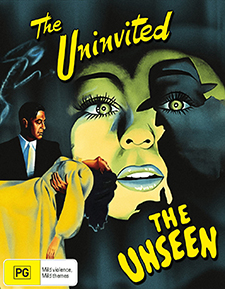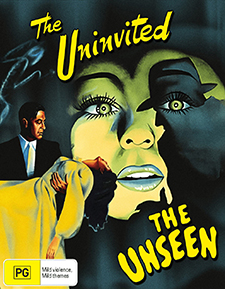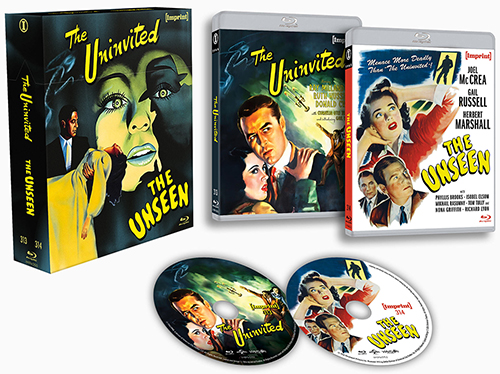Uninvited, The/The Unseen (Blu-ray Review)

Director
Lewis AllenRelease Date(s)
1944/1945 (June 5, 2024)Studio(s)
Paramount Pictures (Imprint Films/Via Vision Entertainment)- Film/Program Grade: See Below
- Video Grade: See Below
- Audio Grade: See Below
- Extras Grade: B
- Overall Grade: B-
Review
[Editor’s Note: This is a Region-Free Australian Blu-ray import.]
Gothic horror was not a mainstay of the film industry when 1944’s The Uninvited and 1945’s The Unseen were released, both of which were directed by Lewis Allen (Desert Fury, Appointment with Danger). Indeed, it wasn’t really a term at all at the time, usually describing the films as suspense or mystery thrillers (which is certainly closer to the mark when referring to The Unseen). Customarily mixed in was a slight bit of comedy and romance as well, attempting to give all audiences several things to enjoy. The Uninvited was also among the first haunted house-type films to take the supernatural elements seriously, as they tended to be a primary source for cinematic tomfoolery. They also birthed what’s described today as supernatural melodrama, telling stories in which undead spirits can’t find their peace until they’ve righted certain wrongs. Yet while The Uninvited is considered a classic, The Unseen faded quickly into obscurity, leaving little evidence of its existence. Because these films share a director and a star (Gail Russell), Imprint Films has paired them together in a new 2-Disc Blu-ray boxed set, with The Unseen appearing on home video for the very first time worldwide.
Based upon the 1941 Dorothy Macardle novel Uneasy Freehold, The Uninvited tells the story of a brother and sister, Roderick and Pamela Fitzgerald (Ray Milland and Ruth Hussey), Londoners who stumble upon a cliffside home, falling in love with it and hoping to purchase it. Inquiring with the owner, Commander Beech (Donald Crisp), he sells the house at a very low price, admitting that the previous tenants complained of strange occurrences. Though suspicious, they accept. As they move in, Roderick becomes infatuated with Beech’s granddaughter, Stella (Gail Russell), whom Beech keeps a short leash on. As the Fitzgeralds and Stella become fast friends, and her and Roderick become closer, odd happenings in the house begin just before dawn, including the sound of a woman weeping. Gail, hoping to learn more of her long-dead mother, finds herself drawn to the house by a seemingly supernatural force, against her grandfather’s wishes.
Many positives are abound in The Uninvited, mostly in atmosphere and structure. In many ways, it’s an atypical old Hollywood type of film that tries to cram in as many things as possible to please as many members of its audience as possible, including mystery, romance, comedy, and suspense, but it’s also a refreshingly simple and straightforward tale. The haunted melodrama of it all became a staple of many films around this time, of course, but none of them had the screen presence of Gail Russell, whose beauty and haunted quality gives the film its edge. It’s also refreshing that the story doesn’t revolve around a gaslighting plot of a husband attempting to drive his wife mad by moving her into a seemingly haunted house for an inheritance or insurance money. Neither Roderick nor Pamela are seeking romance, but they find it throughout the course of the film when meeting others, making them more rounded characters and more interesting to watch.
Anchoring the proceedings further is Ray Milland, whose quick wit and dry sensibility help keep the dialogue fresh and moving, even during the film’s finale when it becomes exposition-heavy. Critics and audiences today now notice the queer overtones and overt references to choosing mistresses over wives, which was noted by the National Legion of Decency at the time. Both of these things are quite minor, but they do stand out for those paying close enough attention.
Among these reasons and more, The Uninvited holds up remarkably well today, carrying with it a spooky atmosphere and likable characters, even within its clichéd Hollywood grip. It also helps that the film is beautifully-shot by Charles Lang Jr. (The Ghost and Mrs. Muir), and features a terrific orchestral score by Victor Young, whose composition Stella by Starlight used within the film became a successful jazz standard among musicians.
The Uninvited was shot by cinematographer Charles Lang Jr. on 35mm black-and-white film, finished photochemically, and presented in the aspect ratio of 1.37:1. Imprint Films brings the film to Blu-ray again with the same restoration included on The Criterion Collection’s 2013 Blu-ray release, which was a 2K digital restoration sourced from a 35mm safety duplicate negative made from a nitrate composite fine-grain. It was a very fine high definition presentation for its time, and it still is, but it doesn’t entirely hold up to modern restorations, hi-def or otherwise. A constant bitrate between 35 and 40Mbps is maintained throughout with decent levels of grain and detail. As this is an aged 2K scan and not sourced from the OCN, detail can be lacking at times, and some portions of the presentation have an almost PAL-like appearance. Grayscale is balanced well enough, though blacks aren’t nearly as deep as they could be. Still, detail in the shadows is impressive. Occasionally there’s mild instability and minor fluctuations in the original materials, as well some speckling and lines, but the majority of the image is pleasant and well-delineated.
Audio is included in English 2.0 mono LPCM with optional subtitles in English SDH. The Criterion Blu-ray offered single-channel mono in the same type of container, but the difference is nil, outside of a little extra speaker space. It’s not a thin or a muffled soundtrack, but it doesn’t have near the sonic reach of more recent mono restorations. Dialogue is king here and it’s clean and clear enough, with good support for sound effects and score. Mild hiss perks up occasionally, usually associated with dialogue, but it’s an otherwise clean track that’s more than adequate.
THE UNINVITED (FILM/VIDEO/AUDIO): A/B+/B
Adapted from the novel Midnight House aka Her Heart in Her Throat by Ethel Lina White, The Unseen sees Gail Russell return in a leading role. She stars as Elizabeth, a newly-hired governess to oversee the children of David Fielding (Joel McCrae), a widower with a penchant for being ill-tempered. His two children, Barney (Richard Lyon) and Ellen (Nona Griffith), couldn’t be more different from each other. Barney hates Elizabeth immediately, declaring her to be his enemy, while Ellen is sweet and becomes fast friends with her. Meanwhile, a story in the newspaper about the recent murder of an old woman in a dark alley nearby has the town scared, especially the hired help. Elizabeth becomes suspicious of what’s going on in the dilapidated house next door at night, and why somebody seems to be coming and going through the cellar, as well as the front door. David, who has long been suspected of murdering his late wife, falls under Elizabeth’s suspicion as to what he’s doing late at night; but without much to go on, she finds herself confiding in David’s friend, Dr. Evans (Herbert Marshall), yet no closer to the truth.
There are likely a couple of reasons why The Unseen has never been available on home video in the US. First of all, it’s not very good. It’s extremely convoluted, sets up things that never pay off, and has what some would call a head-scratching ending, though in my own case, it left me angry and unsatisfied. Apparently, the film was tinkered with relentlessly during the scriptwriting stage, but it’s unclear just how much of what version of the script wound up on screen. You get a pretty good idea of who the perpetrators are early on if you’re paying close attention, which isn’t exactly telegraphed, but there’s only so many characters outside of Elizabeth and the children that it makes it easier to pick them out. The film also opens with a murder that’s heavily narrated to describe what’s happening, Ed Wood-style. It’s a mess, and its conclusion leaves that much more to be desired.
Another reason might come down to rights issues. There’s a scene in which Elizabeth, Barney, and Ellen all go to the movies and they’re watching a Popeye cartoon (optically added to the background), while Nona keeps a scrapbook of Disney characters, most prominently Snow White and the seven dwarfs. Obviously, clearing these kinds of things outside the US is a little easier, but is all of these reasons and more why the film has been missing on home video since its inception? Well, it’s likely a combination of varying factors, and perhaps more that we’re not privy to, as it always is.
Performances range from fine to poor. Gail Russell seems lost most of the time, while Joel McCrae’s job is to be overtly surly one minute and soft and good-natured the next (is this film secretly about spousal abuse?) The kid portraying Barney is also very good, but his sister Ellen is quite charming and believable. In fact, she’s the best thing about the film, and it’s a shame that she isn’t in it more. There’s also some fine cinematography on display from John F. Seitz (Double Indemnity), as shadows play an important part in the film’s overall look.
Unfortunately, The Unseen’s minuses outweigh its pluses. Film fans will be pleased to fill in a cinematic gap, and having a Gail Russell film finally available that’s been locked away in film vaults for decades is certainly a wrong that’s been righted. However, one should go into this one with an open mind and realize that The Uninvited must have been a very hard act to follow.
The Unseen was shot by cinematographer John F. Seitz on 35mm black-and-white film, finished photochemically, and presented in the aspect ratio of 1.33:1. The film debuts on Blu-ray for the first time, skipping past all previous home video formats entirely, with what’s purported to be a new 2K scan of the original camera negative, carried out by Imprint Films. However, this is a clearly from a lower quality source, maybe an interpostive or internegative, but more likely from a film print based upon the level of detail, obvious wear and tear, soundtrack issues (more on that later), and most telling of all, changeover cues. Streaking, scratches, and speckling are frequent, though the bitrate sits between 35 and 40Mbps for the majority of the running time. Regardless, there are blatant compression issues, especially in the darkest scenes. Grayscale is lacking with some crushed blacks, as well, especially when darkness dominates the frame. Despite all of this, it’s still a step up from bootlegs and Youtube presentations, but not nearly up to the standards of its predecessor. It’s watchable, but needs work.
Audio is included in English 2.0 mono LPCM with optional subtitles in English SDH. Like the video portion, the audio also has its share of obvious leftover damage, including hiss, crackle, dropouts, distortion, and mild sibilance. That said, the various elements have decent push to them. Dialogue is discernible and the score comes through well enough.
THE UNSEEN (FILM/VIDEO/AUDIO): C-/C-/C-
Imprint’s Region-Free Blu-ray boxed set containing The Uninvited and The Unseen are presented in separate clear Amaray cases, both featuring their respective original US theatrical artworks. The hardbox slipcase packaging, limited to 1,500 copies, features a very nice collage of a portion of the French theatrical poster artwork for The Uninvited and the main Spanish theatrical poster artwork for The Unseen. The following extras are included, all in HD:
DISC ONE (THE UNINVITED)
- NEW Audio Commentary by Alan K. Rode
- NEW The Uninvited and the Female Gothic (13:44)
- NEW Gail Russell: The Flame That Burned Twice as Bright (29:24)
- Original Radio Adaptations Starring Ray Milland:
- Lady Astor Screen Guild Play with Ruth Hussey & Betty Field (1944) (28:52)
- Screen Directors Playhouse with Director Lewis Allen (1949) (29:49)
- Theatrical Trailer (2:03)
The audio commentary features film scholar, noir expert, and Film Noir Foundation board member Alan K. Rode. He discusses the history of the film’s production, as well as its cast and crew, pausing occasionally, but always offering fascinating information about the film. In The Uninvited and the Female Gothic, writer and film historian Kat Ellinger delves into the Gothic horror genre and how the film fits within it for its era, which is to say not very well as it doesn’t throw up the obvious descriptors, nor does it adhere to genre conventions. In The Flame That Burned Twice as Bright, author and film critic Imogen Sara Smith appears on camera to discuss the life and career of Gail Russell, who unfortunately had a very unhappy life and died far too young, but also talks about the haunted house films of the era, including The Uninvited and The Unseen. Next are two radio adaptations of the film, one from the Lady Astor Screen Guild Theater on August 28, 1944, and the other from the Screen Director’s Playhouse on November 18, 1949. The former features Ruth Hussey and Betty Field, and the latter is directed by Lewis Allen, while both feature Ray Milland. Last is the film’s theatrical trailer.
Not included from Criterion’s Blu-ray release is the visual essay Giving Up the Ghost by filmmaker Michael Almereyda, as well as the insert booklet containing an essay by critic Farran Smith Nehme, and a 1997 interview with director Lewis Allen.
DISC TWO (THE UNSEEN)
- NEW Audio Commentary by Alan K. Rode
- NEW Gothic Noir: The Unseen Touch of Henry James (9:32)
Alan K. Rode returns for another audio commentary covering much of the same subject matter, including the histories of the cast and crew, and the film’s production, among other subjects. Gothic Noir is a new video essay about the film by Max Evry and Imogen Sara Smith, who highlight the film’s similarities to the Henry James story The Turn of the Screw and its many adaptations, which is not necessarily well known or studied by film scholars. They also talk about differences from the original novel versus what wound up in the final film.
Ghost stories are difficult to get right, let alone get invested in, but The Uninvited achieves this well. The Unseen mostly fails as a suspense thriller, being neither suspenseful nor thrilling, despite the talent involved. Regardless, this a nice boxed offering of both films, even if the latter’s presentation leaves room for improvement. Yet having it available legally at all is long overdue.
- Tim Salmons
(You can follow Tim on social media at these links: Twitter, Facebook, and Letterboxd. And be sure to subscribe to his YouTube channel here.)


